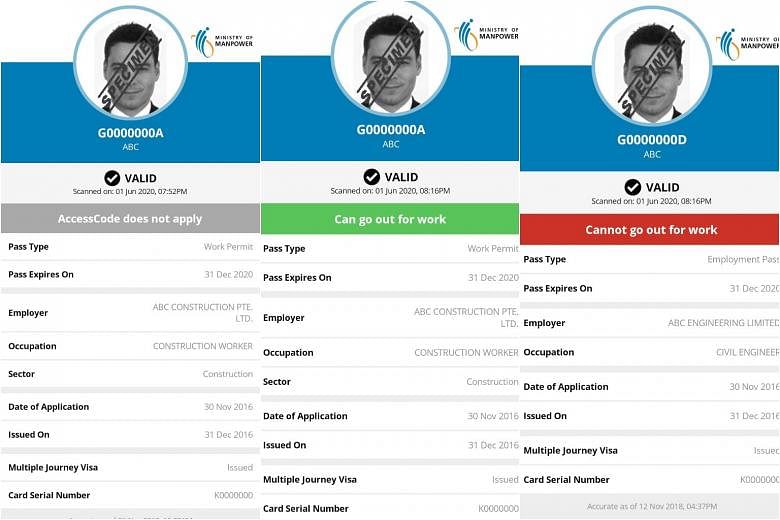A new app, SGWorkPass, will show which migrant workers can leave their dormitories for work.
It is one of the new measures the inter-agency task force handling the Covid-19 situation in the dormitories is rolling out, Manpower Minister Josephine Teo said at a virtual media conference yesterday.
She said almost all migrant workers have downloaded the app, which is one of the technological solutions co-developed with the Defence Science and Technology Agency and GovTech to enable the safe resumption of work.
"This new access code feature will allow the workers themselves, their employers as well as the dormitory operators to have clarity about who can exit the dormitories to work," she said.
Workers will get a "green status" on the app to indicate that their employer has been granted approval to resume operations, and that the dorm they stay in has been cleared.
About 40,000 migrant workers who stayed in dorms have been cleared of Covid-19 infection and may return to work, pending approval from the authorities.
Of these, 12,000 are essential workers who had already been moved out of dorms into other short-term accommodation.
More than 20,000 workers have recovered from the coronavirus and been rehoused at various temporary sites.
A further 8,000 are dorm residents who have either tested negative for Covid-19, or have since fully recovered from the coronavirus, been discharged and are now staying with their fellow workers back in the dorms.
Mrs Teo added that a first batch of 60 dorms - including three purpose-built dorms as well as 57 factory-converted dorms and construction temporary quarters - will be cleared from today.
She said this means that "every block in a dorm has been cleared and every resident in those blocks has been cleared of Covid-19 infection".
The task force has improved medical support for migrant workers to enable them to return to work safely, she noted.
This includes a programme of systematic and regular testing as well as enhanced health surveillance to enable early detection of any infection or re-infection among the cleared workers.
Asked how re-infection can be prevented, Mrs Teo said that greater discipline will have to be instilled in the way workers interact with one another. "The simple idea is that you cannot go back to the practices of the past," she said.
Workers have to be split into cohorts who work and live together, she said. Safe distancing measures must be implemented in the dorms, like erecting barriers between blocks so that residents of different blocks do not mix.
Rest days need to be staggered and workers should use only communal facilities like toilets that they are designated to, she added.
"When you and I go home every day, our household maybe consists of another three, four or five people," she said.
"But for the migrant workers, when they go home to their dormitories, their home is a much bigger home with many more members that they get to interact with.
"So, if you want to reduce the risk, you have got to find a way to do so (such) that the interactions are brought to a minimal level."
Mrs Teo cautioned that re-infection remains a risk, even with all these measures in place.
"What we therefore need to layer on is a rigorous system to test the workers, and that is what we are working on," she said.
This article has been edited for clarity.











